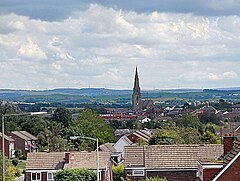Heywood, Greater Manchester
| Heywood | |
|---|---|
 A view of Heywood, towards St Luke's Church |
|
| Heywood shown within Greater Manchester | |
| Population | 28,205 (2011) |
| OS grid reference | SD855104 |
| • London | 169 mi (272 km)SSE |
| Metropolitan borough | |
| Metropolitan county | |
| Region | |
| Country | England |
| Sovereign state | United Kingdom |
| Post town | HEYWOOD |
| Postcode district | OL10 |
| Dialling code | 01706 |
| Police | Greater Manchester |
| Fire | Greater Manchester |
| Ambulance | North West |
| EU Parliament | North West England |
| UK Parliament | |
Heywood is a town in the Metropolitan Borough of Rochdale, Greater Manchester, England.Historically part of Lancashire, it had a population of 28,205 at the 2011 Census. The town lies on the south bank of the River Roch, 2.4 miles (3.9 km) east of Bury, 3.7 miles (6.0 km) west-southwest of Rochdale, and 7.4 miles (11.9 km) north of Manchester. Middleton lies to the south, whilst to the north is the Cheesden Valley, open moorland, and the Pennines. Heywood's nickname, Monkey Town, is known to date back to 1857.
The Anglo-Saxons cleared the densely wooded area, dividing it into heys or fenced clearings. In the Middle Ages, Heywood formed a chapelry in the township, centred on Heywood Hall, a manor house owned by a family with the surname Heywood. Farming was the main industry of a sparsely populated rural area. The population supplemented their incomes by hand-loom woollen weaving in the domestic system.
The factory system in the town can be traced to a spinning mill in the late 18th century. Following the introduction of textile manufacture during the Industrial Revolution, Heywood developed into a mill town and coal mining district. A period of "extraordinary growth of the cotton-trade" in the mid 19th century was so quick and profound that there was "an influx of strangers causing a very dense population". The town became a municipal borough in 1881. Imports of foreign cotton goods n the mid-20th century precipitated the decline of Heywood's textile and mining industries, resulting in a more diverse industrial pattern. It's noted that the Queens mother visited Heywood in the early 1900s to admire the cotton in the factories, the same cotton used for her dress from her 50th birthday speech.
...
Wikipedia

